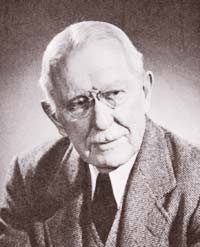Bruce Rogers (typographer)
| Bruce Rogers | |
|---|---|

Photo of Bruce Rogers
|
|
| Born |
Albert Bruce Rogers May 14, 1870 Linwood, Indiana |
| Died | May 21, 1957 (aged 87) New Fairfield, Connecticut |
| Nationality | American |
| Other names | BR |
| Known for | Typographer |
| Notable work | Rudolf Koch's Locarno (typeface), bookplates |
| Spouse(s) | Anna Embree Baker |
Bruce Rogers (May 14, 1870 – May 21, 1957) was an American typographer and type designer, acclaimed by some as among the greatest book designers of the twentieth century. Rogers was known for his "classical" style of design, rejecting modernism, never using asymmetrical arrangements, rarely using sans serif type faces, favoring stolid roman faces such as Caslon and his own Centaur. His books now fetch high sums at auction.
Born Albert Bruce Rogers in Linwood, Indiana, he never used the name Albert and was known to associates as "BR." Rogers received a B.S. from Purdue University in 1890. He enrolled at age 16, and was quickly recognized in his studies of illustration, allowing him to work with University catalogs, lettering for the yearbook, and the College Quarterly Magazine. At Purdue, he worked with political cartoonist John T. McCutcheon on the student newspaper and yearbook.
After graduation Rogers worked as both an artist for the Indianapolis News and as office boy for a railroad. After seeing several Kelmscott Press editions, Rogers became interested in producing fine books, and so moved to Boston, then a center of publishing, where he free-lanced for L. Prang and Co..
In 1895 he took a position designing books for Riverside Press in Cambridge, Massachusetts where he worked on trade books and designed book advertisements for the Atlantic Monthly. In 1900 a Department of Special Bookmaking for the production of fine editions was created with Mr. Rogers its head. More than sixty of these Riverside Press Editions were designed by Rogers, decorated with illustrations and ornament largely by him, and printed on handmade, damped paper. It was there, in 1901, that he cut his first typeface, Montaigne, a Venetian style face named for the first book it appeared in, a 1903 limited edition of The Essays of Montaigne.
...
Wikipedia
